Price is always the first filter of component choice, so what should you expect for you wad? Because we're dealing with upgrade forks in this test we've started our selection at £300. You can get forks cheaper, but skinny legs, quick-release (QR) axles and basic springs and damping badly protected by leaky seals means few are worth buying.

Mountain bike suspension forks
by karamela
The best 140 to 180mm travel trail suspension forks to the limit to find the best front-end upgrade for every riding style and budget.
Low end forks
For £300 you should get a decent chassis, which will often be a hand-me-down from a previously more expensive fork - for example, the Sektor being old Revelation. You should get reliable seals and adjustable rebound damping that gives a consistent and controlled return. There should be no banging bottom-out at full compression or top-out when it returns. Because Europeans love them, you'll often find lockout levers for smooth surface sprinting too but we don't know many UK riders who use them much. Screw-through axles are a really useful option that's increasingly common on cost-effective forks, but remember a matching through-axle wheel (or a rebuild onto a new hub) adds a big extra cost if you're existing one can't be converted easily. Aggressively priced brands like X-Fusion and Suntour mean this mid-price market contains some really impressive forks now.
Mid - high end forks
At the price of a fork increases to between £500 and £700 you'll get more complicated damping systems with separate high and low speed compression damping adjustment. Chassis design also becomes more refined, which hopefully means lighter and/or stiffer results. When prices start to exceed £800, you should be getting something really special. Ultralight expensive material such as carbon fiber, surface treatment such as Fox's Kashima coating or pro raced derived damping circuitry such as RockShox' Mission Control DH.
You obviously need to choose the right travel for your riding and your bike too. If you're after a 100 to 140mm travel fork then you need to check the simultaneous review of another 15 shorter-travel forks. We've concentrated on 140 to 180mm travel because the longer the fork, the more stroke it has to control a hit. Therefore the temptation for trail riding is always to add travel. Always check your frame warranty for the maximum recommended fork length before fitting a new one though. Even if it's safe increasing travel by over 20mm from original spec will make big changes to geometry. While a slacker head angle can be fun, a higher bottom bracked can really ruin things.
Wheels
Finally we need to talk about wheel size. Many forks are 26in wheel versions mostly for freeride and downhill riding style. Some are available in 650B or 29er versions thought and where they are we've included relevant notes, because comparative performance can be very different.
Damping. The impact energy coming into the fork is dissipated and controlled by a valved piston pushing through hydraulic oil and converting it into heat. Changing the oil flow speed changes how the fork behaves when it's taking a battering.
Spring. Most forks now use a pressurised air chamber as a spring. It's lighter than a coil spring and more easy adjusted with a pump.
Legs. The lower legs are held together by a hopped brace (or braves) and contain the bushing that the upper legs (stanchions) slide up and down on. The stanchions contain the spring on the on side and the damping circuits on the other. Stanchion diameters here vary from 32 to 36mm.
Top end. All the forks tested here are single crown designs rather than restricted steering dual crown 'triple-clamp' downhill forks. Tapered head tubes and tapered fork use a 1.5in bottom diameter but a smaller 1.125in top diameter to save steerer and stem weight without sacrificing stiffness.
Axle. Some cheaper, shorter travel forks still use a quick-release (QR) skewer and open dropouts. Screw-through axles in 15mm or 20mm diameter add significant security and stiffness to the fork/wheel connection though. There are various different designs but most work fine if they're kept clean.
Flashback
1991 Original RS1
Always pushing things forward, RockShox released one of the first suspension forks, the RS1 in 1991. Weighing 1.4kg, the RS1 had 49mm (1.9in) travel. The alloy crown was revolutionary and the chromoly bolt-on brace helped keep the RS1 stiff. An air spring system and oil damping doesn't put the RS1 a million miles away from the forks of today.
2013 Revelation RCT3
The revelation puts out anything from 100 to 150mm of travel and weighs 1.63kg. Keeping with the times it's available in 26in, 650B and 29in wheel size options, and there are choices of axle and steerer tube size too. The one-piece carbon crown and steerer is cutting edge, and using an air spring system, the Revelation's adjustable compression and rebound damping makes set-up easy.
Bike forks jargon buster
Bottom-out. The full compression point of the stroke. Should be smooth and controlled, not harsh.
High-speed compression. Damping that deals with big or fast square-edge hits.
Linear. Fork that maintains a similar spring rate throughtout the stroke. Alows less aggressive riders to easily access full travel for a smooth ride.
Low-speed compression. Damping that deals with smaller, slower arriving forces such as corner compressions, braking or out of the saddle pedalling.
Position sensitive. Damping or spring characteristics designed to change depending on where you are on the stroke.
Progression. The increase in spring rate as the fork compresses. Stops it bottoming out harshly or diving to deep when cornering or breaking hard.
Rebound. The return stroke of the fork after an impact.
Remote. A control switch mounted on the handlebars and linked to the fork with cable or hydraulic hose.
Stanchion. Tubes of the upper fork leg.
Stiction. Initial resistance to fork movement caused by tight seals.
Stroke.The movement of the fork as it compresses.
Tapered. Steerer tube with a 1.5in bottom diameter and 1.125in top
Fox Racing Shox 2013 fork lineup
You might also like
Differences between freeride and downhill bikeThere is always a great dilemma when it comes to buying a new bike for freeri...
Double frontflip on a mountain bikeThe frontflip has been one of the most dangerous, challenging tricks in mount...
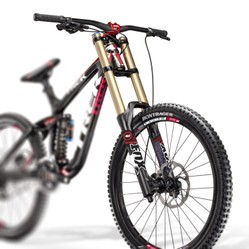


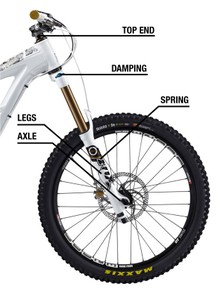
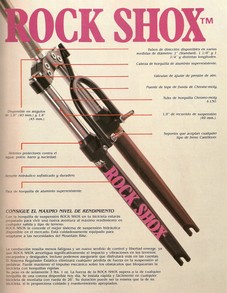
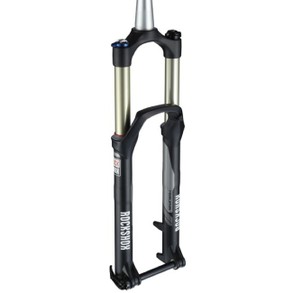

 Film Clapperboardon 04/25/2013
Film Clapperboardon 04/25/2013
 DSLR camera for filmmakingon 03/03/2013
DSLR camera for filmmakingon 03/03/2013
 Double frontflip on a mountain bikeon 11/06/2011
Double frontflip on a mountain bikeon 11/06/2011
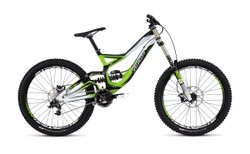

Comments